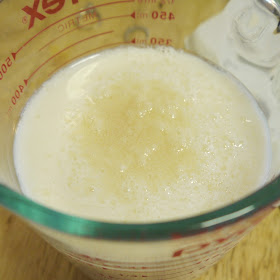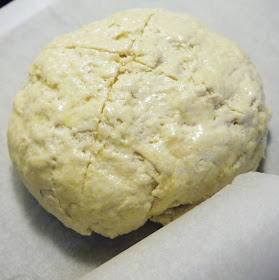The Setting: The day after a snow storm.... The roads are now clear, but my car is still buried. I think I'll be staying in today.
The Soundtrack: Boy Meets World (I'd say it was on for the wee one, but we all know I'm just indulging my inner twelve year old).
On the Stovetop: Cabbage and onion soup.
The Scenario: When snow storms roll in, the oven warms up.
Winter may be almost over, but here in the Midwest, it's still soup-and-soda-bread weather.
More than just a staple on St. Patrick's Day tables, soda bread is a hearty, make-anytime treat that can be mixed up, shaped, and pulled from the oven in little more than an hour--no rising or forethought necessary.
Traditionally, buttermilk (acidic) and baking soda (basic) are used to give this loaf its lift. This version uses acidic and flavorful unfiltered-cider vinegar instead of buttermilk to activate the baking soda, resulting in an especially tangy loaf with a pleasing complexity.
If you can't find (or don't want to use) a raw, organic, unfiltered-apple-cider vinegar (such as Bragg or Spectrum Naturals) add a pinch of yeast to regular cider vinegar (when you mix it with the milk) to approximate the taste.
I like to use a mixture of unbleached all-purpose flour and whole-wheat pastry flour to keep this loaf tender. If you don't have pastry flour, substitute 1/4 cup cornstarch for an equal amount of the flour. This will reduce the amount of gluten in the recipe and help prevent the bread from becoming too tough.
As with all quick-breads, it is also important to work the dough as little as possible after adding the liquids to keep gluten-development (and thus toughness) to a minimum.
Whether topped with butter and jam or dunked in stew, this bread is best served within a few hours of baking. Leftovers, however, make excellent toast.
Cider-Vinegar Soda Bread
1 3/4 cups milk (skim is fine)
1/4 cup unfiltered apple cider vinegar (or regular apple cider vinegar plus a pinch of yeast)
2 cups whole wheat pastry flour
2 cups all-purpose flour
1 1/2 tsp baking soda
1 1/2 tsp fine salt
2 tsp malted milk powder
2 T brown sugar
3 T cold, unsalted butter, chopped into pieces
1 T butter, melted
Preheat the oven to 400 degrees Fahrenheit. Line a baking sheet with parchment paper.
In a small bowl combine the milk and cider vinegar (plus yeast, if using). Set aside.
In a large bowl whisk together the flours, soda, salt, malted milk powder, and brown sugar until thoroughly mixed.
Use a pastry cutter (or fork) to cut the butter into the flour mixture, raking the chunks of butter through the dry ingredients until the mixture resembles fluffy, slightly damp sand.
By now the milk mixture should look like this:
Use a wooden spoon or rubber spatula to slowly incorporate the milk mixture into the flour mixture, striving to get the dry ingredients as evenly wet as possible, while working the dough as little as possible. Use your hands to finish incorporating the dry ingredients, adding an extra teaspoon or so of milk if needed.
Pat the dough into a round loaf and place it on the prepared baking sheet. Brush the top of the dough with the melted butter and use a paring knife to slice an X across the top of the loaf.
Bake at 400 degrees Fahrenheit for 40 minutes, rotating the pan halfway through for even cooking. Let cool at least 15 minutes before cutting.
Thanks for reading! Here's to Being the Secret Ingredient in your life.
+(798x800).jpg)










.JPG)
No comments:
Post a Comment
Thank you so much for your readership! If you have any trouble leaving a message, please email morgandenneyjohnston@gmail.com